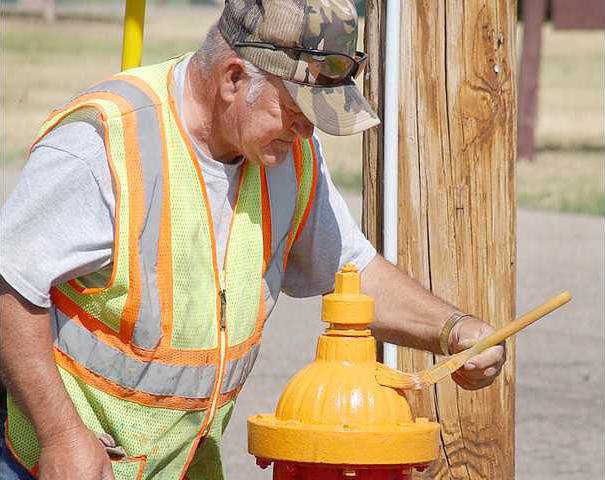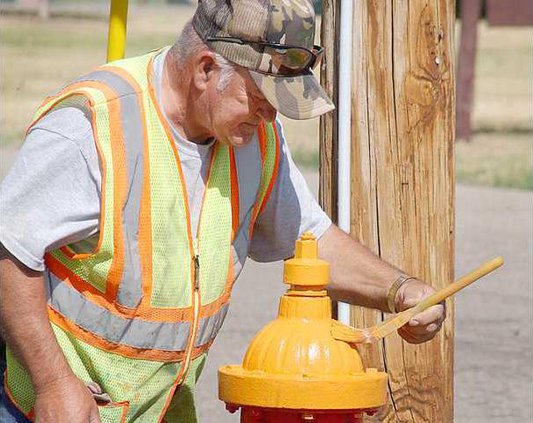What do the colors mean?
The City of Great Bend Water Department is in the progress of color coding all fire hydrants based on water outflow. When finished, the top bonnets of each hydrant will be painted to represent flow. Blue means (1500 or greater gallons per minute) “very good”; green (1000 - 1499 GPM) is “good”; orange (500 - 999 GPM) is “marginally adequate”; and red (0 - 500 GPM) is “minimal.”
City officials stressed, however, even a “minimal” hydrant is adequate to handle fire fighting.
Emery Hoch pulled up to the fire hydrant in Britt Spaugh Park Wednesday morning, hopped out of his City of Great Bend pickup and set up orange cones.
He then grabbed a bucket of paint and brush from the truck bed and went to work.
Hoch, who retired after 36 years with the city’s Wastewater Treatment Plant, is working part time for the Water Department. His goal is to paint the tops, or bonnets, of each of the city’s 500-plus red fire plugs.
“We are in the process of color coding all fire hydrants based on water outflow,” said Charlie Suchy, utility superintendent, of the department. This flow ranges from 1,500 down to 500 gallons per minute, and the different colors denote that – from blue to green to orange and down to red.
“Hopefully by the end of the year, Great Bend’s fire hydrants will have a new splash of color as a means of identifying each one’s quality during normal conditions,” Suchy said.
A hydrant is considered minimal if it spews less than 500 gallons of water a minute. “We like to see orange, green or blue,” said Fire Chief Mike Napolitano. The ideal classification for a fire hydrant is 1,500 gallons or more, but “please keep in mind, just because you have a red hydrant does not mean we can’t fight a fire successfully, it just gives us the available flow so we can adjust accordingly.”
Great Bend has 10 water wells inside the city with 580 hydrants, Suchy said. The city uses only three wells under normal conditions and that is enough to feed the city’s 90-mile closed loop of water lines.
By state law, a municipality must maintain system-wide water pressure of at least 20 pounds per square inch. But, in the event of a fire or other large water use, that pressure can drop.
So, “we have the capabilities to turn on additional wells if needed when additional flows are needed,” he said. Many will kick in automatically.
There are also two water wells and a water tower at the Great Bend Municipal Airport with 60 hydrants, including the Expo area. But, Suchy said, this system is separate from the city proper.
In 2011 Suchy’s department painted all fire hydrants red, keeping in mind the goal to color code all fire hydrants in 2012.
All color coding is according to the National Fire Protection Association standards and the four colors are standard colors for bonnets to indicate the hydrant’s available flow at 20 psi. “We have a lot of inquiries from citizens wanting to landscape around the fire hydrant or paint their own colors,” he said. “Please remember the color coding procedures the city uses, and when landscaping.”
Also, the fire department requires and needs full access. The hydrant needs at least three feet of clear area around it and “be in full visual view.”
All maintenance of the hydrants is handled by the Water Department and include flushing, inspection/inventory, repair, and replacement as needed. The goal is to replace at least five hydrants a year, until all older less sufficient hydrants have been replaced.
“We’re trying to update the whole system,” Suchy said.
An added benefit
The hydrant maintenance helps the city in another way, Napolitano said. Insurance Services Office Inc. conducts periodic surveys of city hydrant systems. This Public Classification Program plays an important role in the underwriting process at insurance companies.
Eight to 10 years ago, the city had a rating of 5. Today, the rating is 3, which means lower insurance rates for the city. The chief said the efforts of Suchy and his department will help Great Bend maintain that lower rating.
ISO’s survey was used to determine what hydrants were painted what color.





